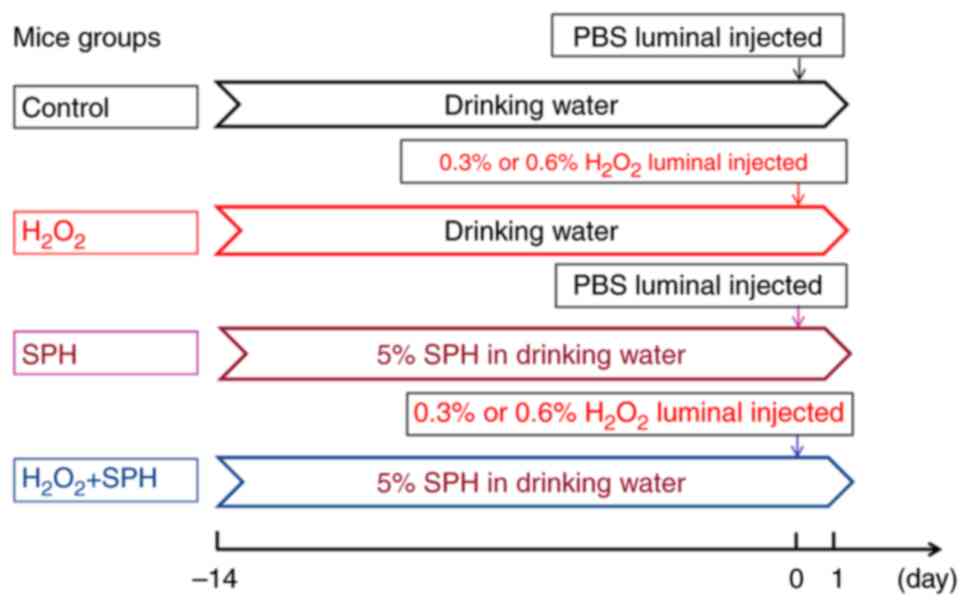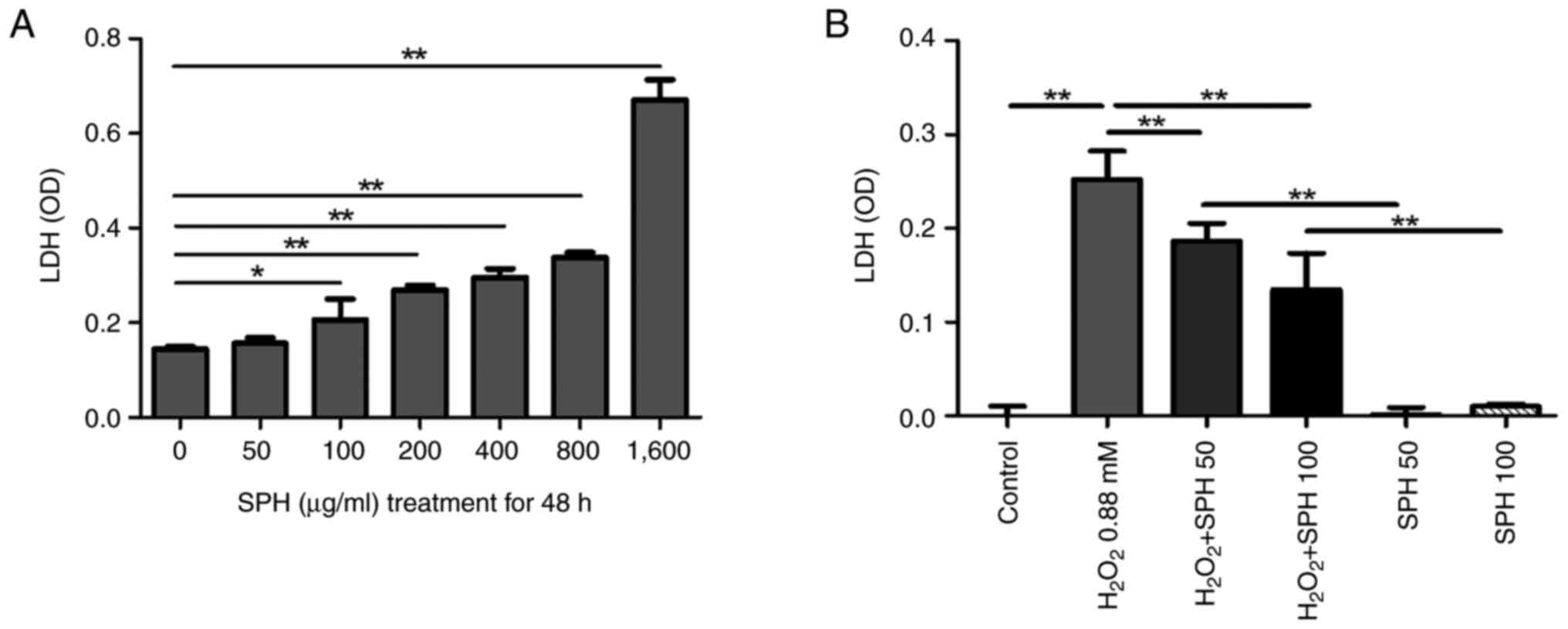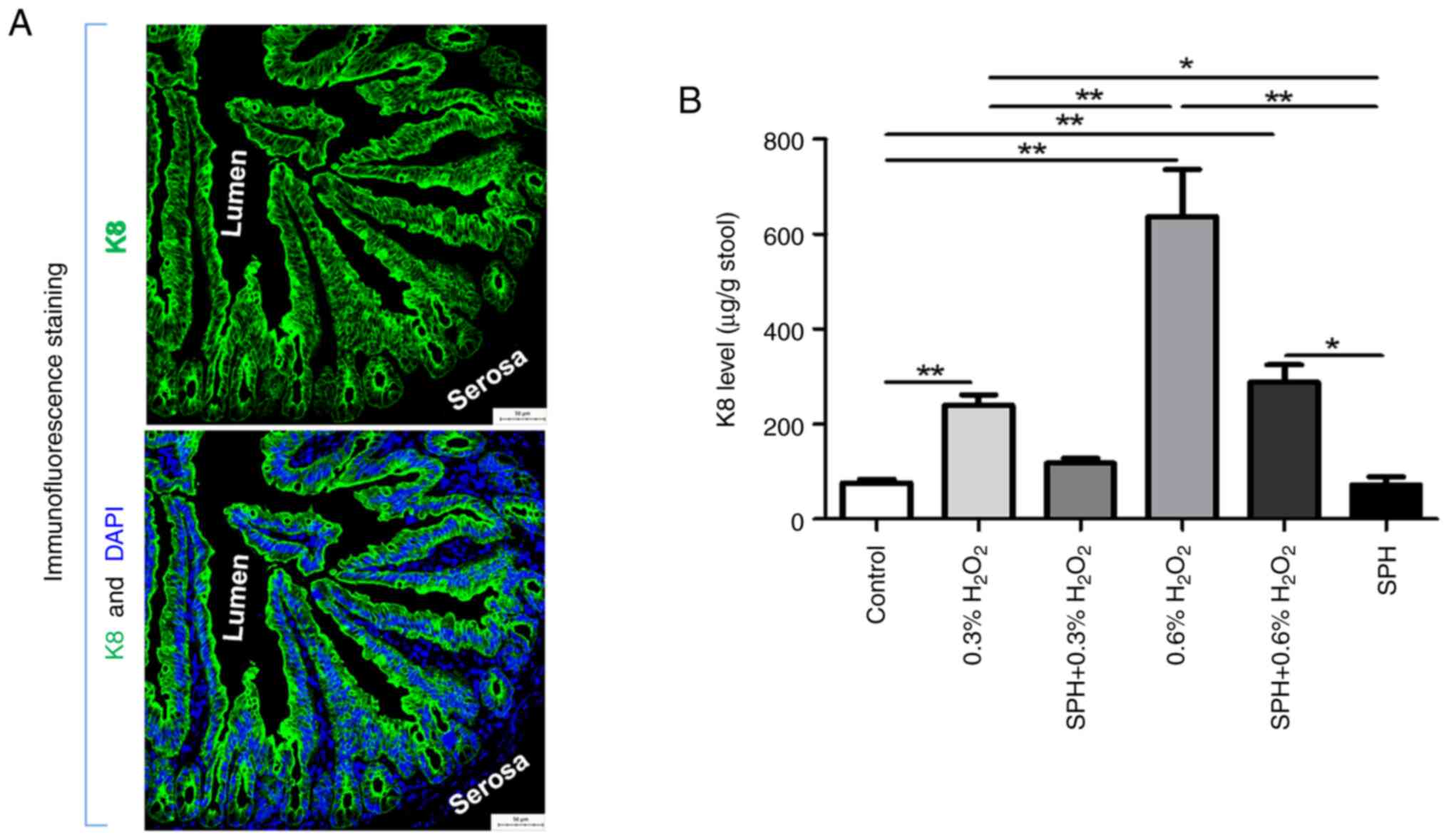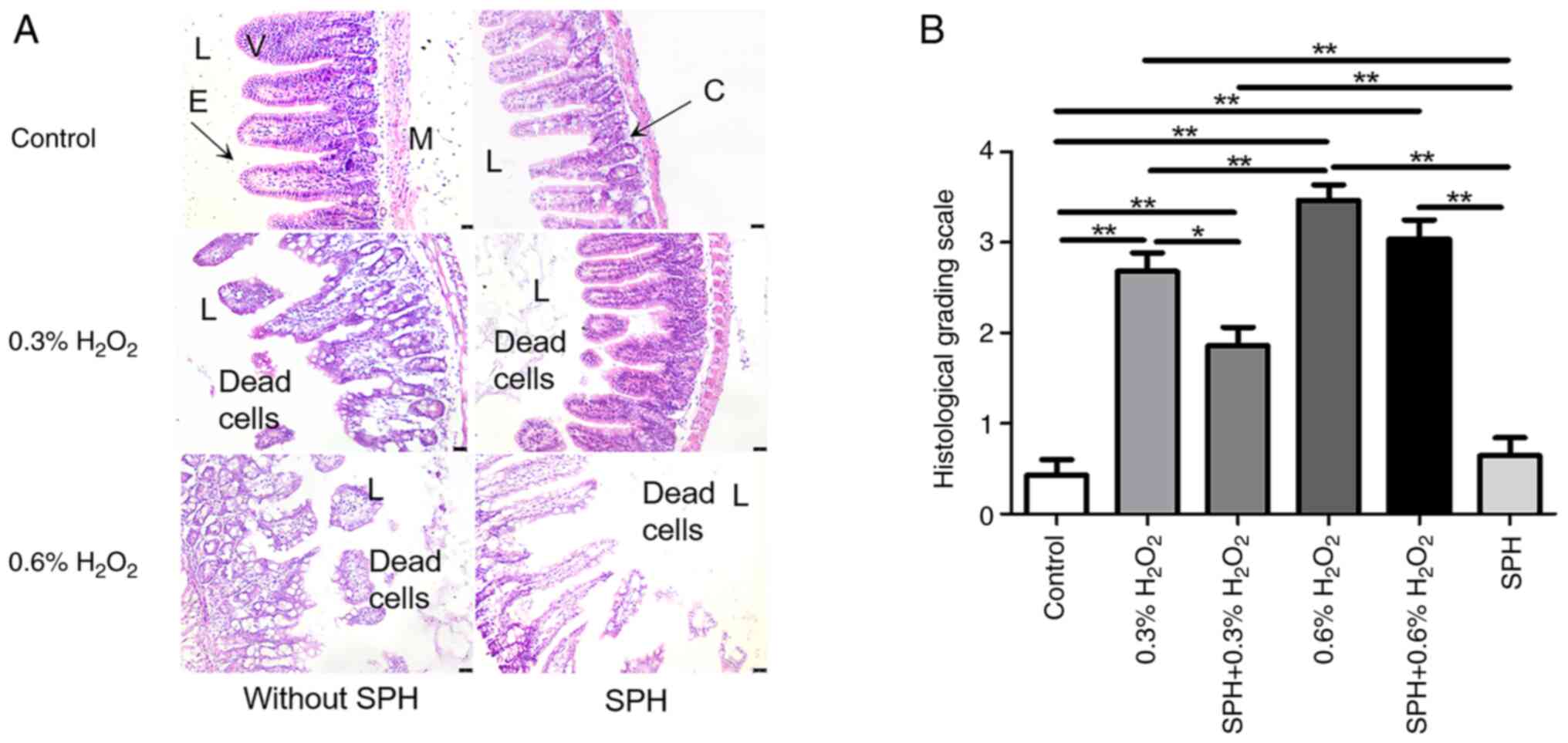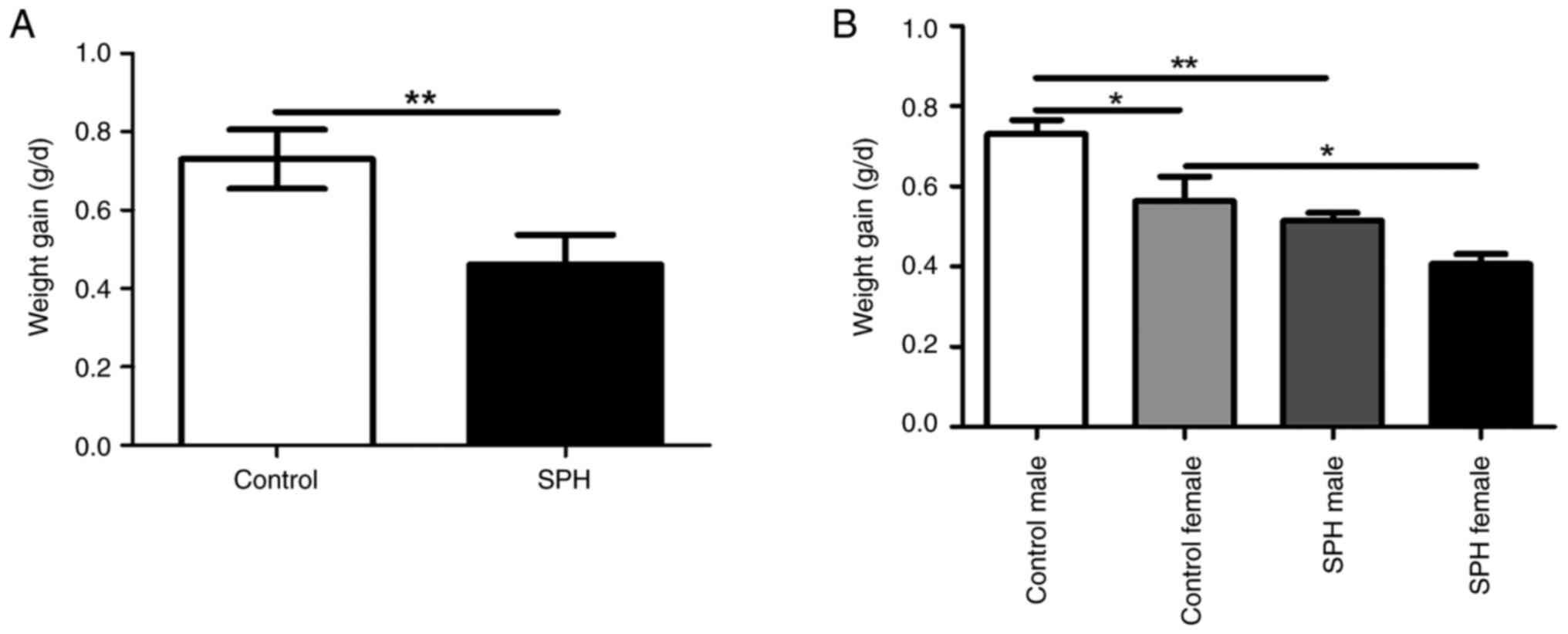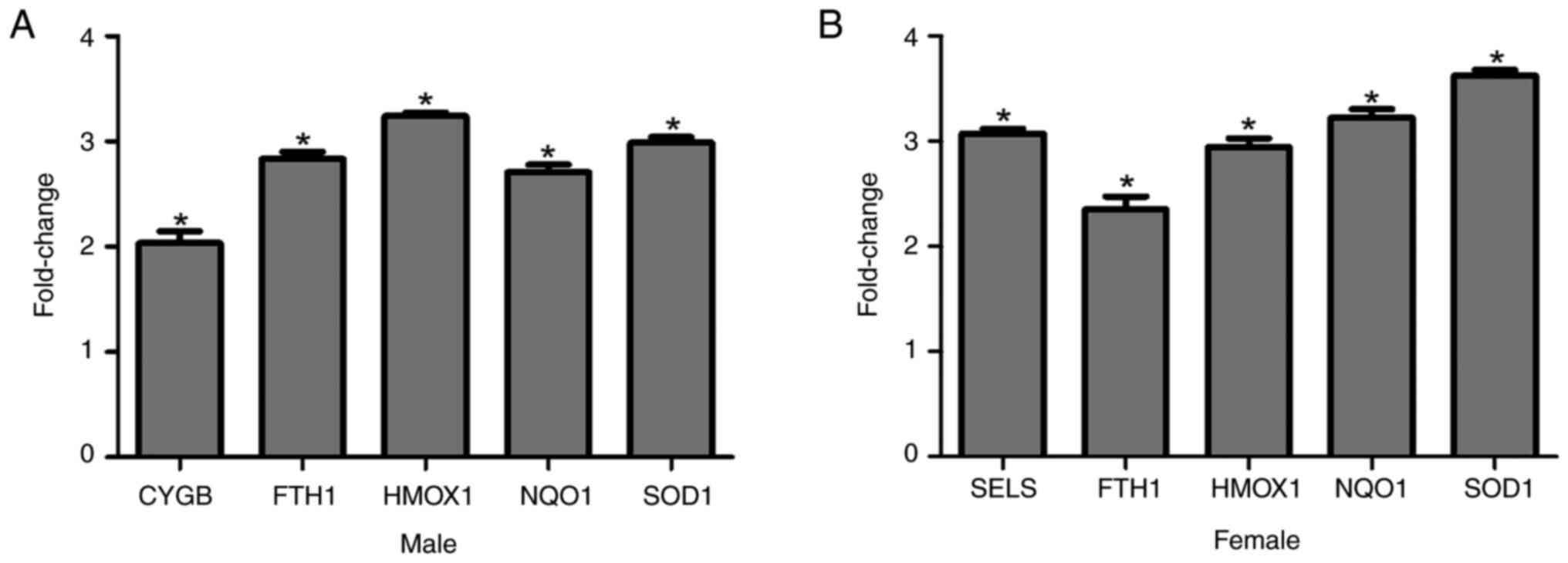Protective effect of soluble protein hydrolysate against H2O2‑induced intestinal injury: An interventional study
- Authors:
- Published online on: January 29, 2025 https://doi.org/10.3892/mmr.2025.13450
- Article Number: 85
-
Copyright: © Wei et al. This is an open access article distributed under the terms of Creative Commons Attribution License.
Abstract
Introduction
Oxidative stress due to the imbalance between reactive oxygen species (ROS) generation and the capacity of antioxidant defense systems is a contributing factor or common mechanism in numerous diseases such as cancer, cardiovascular, neurological, respiratory, kidney and gastrointestinal mucosal diseases (1–3). ROS are generated under both physiological and pathological conditions including mitochondrial respiration, immune cell activation, inflammation, infection, ischemia, aging, exposure to toxic exogenous substances (such as heavy metals, cigarette smoke and environmental pollutants), alcohol, radiations and certain drugs (1). Low and moderate levels of intracellular ROS, mainly derived from electron leakage in the electron transport chain during cellular respiration, exert beneficial effects on certain physiological activities, serving as essential signaling molecules (1). However, high ROS levels during pathological or stressful conditions can cause oxidative stress and damage important biomolecules, including proteins, lipids, carbohydrates and nucleic acids (1). Furthermore, cellular structures and functions can be irreversibly impaired due to a persistent redox imbalance, ultimately leading to cell death and the aforementioned diseases (1–4). Mammalian cells exhibit various antioxidant defense systems, involving enzymatic and non-enzymatic mechanisms, to maintain normal ROS levels, preventing adverse effects of free radicals and oxidative stress (3).
Endogenous enzymatic antioxidants include direct (first line) antioxidant enzymes and indirect detoxifying (conjugating) enzymes. Direct antioxidant enzymes, such as superoxide dismutase (SOD), catalase (CAT) and glutathione peroxidase (GPx), directly inactivate ROS to prevent reactions initiated by ROS (3,4). Indirect antioxidant enzymes, such as glutathione S-transferase isozymes, NADP(H):quinine oxidoreductase (NQO1) and heme oxygenase (HMOX or HO-1), maintain redox homeostasis through reduction/conjugation reactions, thus performing a detoxifying role (5–7). These enzymes also promote the excretion of secondary oxidized reactive metabolites, such as epoxides, peroxides, quinones and aldehydes (3–6). Moreover, endogenous non-enzymatic antioxidants, such as ferritin, glutathione, thioredoxin and melatonin, also inhibit ROS formation (8). Additionally, several exogenous antioxidants are derived primarily from the diet or nutritional supplements, including vitamin C and E, carotenoids, certain minerals and polyphenols, and are crucial for individuals with malnutrition or malabsorption (2,3).
The gastrointestinal tract is susceptible to ROS-related injury because of its accessibility to the external environment. Oxidative stress is also implicated in numerous gastrointestinal mucosal diseases such as gastritis, colonic inflammation, inflammatory bowel disease (IBD) and cancer (2). Therefore, incorporating antioxidants into treatment regimens is a viable approach to alleviate gastrointestinal tissue damage and these oxidative stress-related diseases (2).
Protein hydrolysates, composed of different proteins and bioactive peptides hydrolyzed from intact proteins, exhibit potential health benefits and antioxidative, antithrombotic, antihypertensive, antimicrobial, anticancer and immunomodulatory properties (9–13). Protein hydrolysates from fish have been reported to reduce H2O2-induced oxidative stress, enhancing cellular tolerance to subsequent apoptosis (11). Soluble protein hydrolysate (SPH), also termed ProGo, which is produced by Hofseth BioCare ASA, contains various potential bioactive peptides derived from the hydrolysis of fresh salmon protein through a proprietary process and non-genetically modified organism protease enzymes (13). Previous studies have reported health benefits of SPH, including antioxidant effects (10–13). Therefore, the present study aimed to investigate the protective effect of soluble protein hydrolysate (SPH) against H2O2-induced intestinal oxidative stress injury and explore the underlying mechanisms using in vivo and in vitro experiments.
Materials and methods
Cell culture
Human intestinal epithelial cells (HIEC-6) were purchased from the American Type Culture Collection and cultured in Opti-MEM Reduced Serum Medium supplemented with 10% fetal bovine serum (FBS), 20 mM HEPES, 10 mM GlutaMAX, 10 ng/ml epidermal growth factor and 1% penicillin-streptomycin, all of which were obtained from Gibco (Thermo Fisher Scientific, Inc.). HIEC-6 cells were seeded in 96-well plates at 70% confluency and cultured in a 5% CO2 incubator at 37°C for 24 h. After which, the cells were cultured with SPH (Hofseth BioCare ASA) at increasing concentrations (0, 50, 100, 200, 400, 800 and 1,600 µg/ml) at 37°C for 48 h. SPH powder was first diluted to 10 mg/ml with phosphate-buffered saline (PBS), and then added into the complete culture medium to achieve final concentrations of 50, 100, 200, 400, 800 and 1,600 µg/ml as required. SPH cytotoxicity at different concentrations in HIEC-6 cells was assessed based on lactate dehydrogenase (LDH) levels in the culture medium using an LDH assay. Accordingly, 50 and 100 µg/ml SPH concentrations were selected for subsequent experiments. Cells in the control group, 50 and 100 µg/ml SPH groups were cultured in complete culture medium containing 0, 50 and 100 µg/ml SPH, respectively and incubated at 37°C for 4 days (8 wells/group). Subsequently, half of the cells in these three groups (4 wells/group) were treated with 0.88 mM H2O2 and further cultured at 37°C for 48 h. The other half of the cells were cultured at 37°C for 48 h without treatment. The protective role of SPH against H2O2-induced cell death was determined based on the LDH concentration released into the culture medium.
LDH assay
A total of 50 µl supernatant was collected from each well of a 96-well plate and transferred to another plate in triplicate. After which, 50 µl 2% NP40 (Thermo Fisher Scientific, Inc.) was added to each well, followed by incubation at room temperature with shaking for 15 min. Thereafter, 100 µl of LDH cytotoxicity detection kit (Takara Bio Inc.) solution was added into each well. Following incubation at room temperature for 15 min, optical density (OD) was measured at 492 nm with a filter at 620 nm using an i3× multimode microplate reader (Molecular Devices, LLC.). In the LDH assay, higher OD values indicated greater cell death.
Animal model
Animal experiments were conducted in an animal facility at Stanford University using a protocol approved by The Stanford University School of Medicine Institutional Animal Care and Use Committee (Stanford, USA; approval no. A3213-01) in accordance with NIH guidelines of the Animal Welfare Act, and the Guide for the Care and Use of Laboratory Animals (14). Male and female friend virus B NIH Jackson mice used for breeding were purchased from The Jackson Laboratory and bred in a barrier-controlled, specific pathogen-free environment overseen by The Administrative Panel on Laboratory Animal Care at Stanford University. The temperature and relative humidity of the environment were maintained at 20±2°C and 55±5%, respectively, with a 12 h light-dark cycle.
Briefly, 56 mice (21 days old and 10–14 g) were randomly divided into six groups: i) Control [n=10; 5M (male)/5F (female)]; ii) 0.3% H2O2 group (n=10; 5M/5F); iii) 0.6% H2O2 group (n=10; 5M/5F); iv) 0.3% H2O2+SPH group (n=10; 5M/5F); v) 0.6% H2O2+SPH group (n=10; 5M/5F); and vi) SPH group (n=6; 3M/3F; Fig. 1). All the mice had ad libitum access to high-pressure sterilized food. For SPH intervention, 5% (w/v) SPH was administered to the mice via drinking water for 14 days immediately after weaning, whereas the other mice had ad libitum access to normal filtered drinking water. Subsequently, the mice underwent a survival surgical procedure involving an intestinal injection. Mice were anesthetized with 3 and 1.5% isoflurane-mixed gas for induction and maintenance, respectively. The surgical site was cleaned with 70% alcohol and a 1.0-cm midline abdominal incision was made. After exposing the small intestine, H2O2 solution at different concentrations was injected into the intestinal lumen adjacent to the ileocecal region, and the abdominal wall was sutured. The mice were then placed in clean cages to collect fecal samples. After 24 h, the mice were euthanized in a CO2 chamber equipped with an automatic air flow-regulator at a fill rate of 50% displacement of the chamber volume/min with CO2, and the small intestines were harvested. Mice in the control group were administered PBS instead of H2O2.
Notably, H2O2 at concentrations of 0.3 and 0.6% were used based on the mortality of mice treated with various concentrations of H2O2 in preliminary experiments, in which the intervention method was the same as that aforementioned. When the concentration of H2O2 ≥1.0%, the mortality rate of the mice increased (Fig. S1).
Histopathological examination and histological grading
Intestinal tissues from the mice were fixed in 4% paraformaldehyde solution overnight at 20–25°C, embedded in paraffin and sliced into 8-µm sections. After which, the sections were dewaxed, hydrated and stained using a hematoxylin and eosin (H&E) staining kit (ScyTek Laboratories, Inc.) following the manufacturer's instructions. The H&E-stained tissue sections were observed under a microscope (BX53; Olympus Corporation) and scored by two blinded observers according to the following histopathological scoring criteria (15): 0, normal; 1, slight epithelial separation; 2, moderate submucosal separation and local villus necrosis; 3, severe submucosal separation and villus necrosis; and 4, transmural intestinal necrosis. Each observer captured a high-magnification field of view of the typical lesion site on each pathological slide for scoring and capturing images. The scores from the two observers were summarized and statistically analyzed.
Modified enzyme-linked immunosorbent assay (ELISA)
The insoluble protein cytokeratin-8 (K8) is the primary component of intermediate filaments in monolayer epithelial cells such as enterocytes and cannot be detected using the traditional ELISA method for soluble proteins (16). Intestinal epithelial damage due to various pathological conditions may significantly increase K8 levels in feces (13,16). Therefore, fecal K8 level can serve as an indicator of the extent of intestinal epithelial damage. Fecal samples collected from the mice were diluted at a mass-to-volume ratio of 1:5, and K8 levels were measured using the rat anti-mouse K8 antibody Troma-1 (cat. no. MABT329M; MilliporeSigma) following the modified ELISA protocol (16) and a SpectraMax® i3× microplate reader (Molecular Devices, LLC.). The final K8 concentration was determined using a standard curve.
Immunofluorescence staining
Immunofluorescence staining for K8 in the gut of mice in the control group was conducted to confirm its abundance and epithelial specific expression. The intestinal tissue sections were prepared as aforementioned for H&E staining, blocked with a PBS solution containing 10% FBS (cat. no. A5256701; Gibco; Thermo Fisher Scientific, Inc.), and incubated at 20–25°C for 30 min. After which, the sections were incubated with the K8 primary antibody (1:500; cat. no. MABT329M; MilliporeSigma) at 4°C overnight. Thereafter, the sections were exposed to a fluorescein 5-isothiocyanate-conjugated goat anti-rat secondary antibody (1:500; cat. no. F6258; Sigma-Aldrich; Merck KGaA) for 60 min at 20–25°C. Following nuclei staining with DAPI (Sigma-Aldrich; Merck KGaA) for 5 min at 20–25°C, the sections were sealed, observed under a fluorescence microscope (BX53; Olympus Corporation), and images were captured at 200× magnification.
Assessment of oxidative stress-related gene expression
The expression of 84 genes related to antioxidant and ROS metabolism in the intestinal tissues of mice was determined. The RNeasy UCP Micro kit (cat. no. 73934), Reverse Transcriptase Mix (cat. no. RT32-010), RT2 SYBR Green Fluor qPCR Mastermix (cat. no. 330512) and RT2 Profiler™ PCR Array Mouse Oxidative Stress and Antioxidant Defense (including the forward and reverse primers for 84 related genes; cat. no. 330231) were purchased from Qiagen GmbH and used following the manufacturer's instructions. The thermocycling protocol for PCR amplification was 95°C for 10 min, followed by 40 cycles of 95°C for 15 sec and 60°C for 1 min, using an iCycler PCR system (Bio-Rad Laboratories, Inc.). Gene expressions were compared using the 2−ΔΔCq method (17) with normalization to the mean expression of the housekeeping genes, including Actb, B2m, Gapdh, Hprt and Rpl13a. Subsequently, the fold change for genes with different expressions between the H2O2 + SPH and H2O2 groups was also calculated as follows: The fold change of a gene (triplicate)=2−ΔΔCq of the H2O2+SPH group/2−ΔΔCq of the H2O2 group.
Statistical analysis
Normally distributed quantitative data conforming to the homogeneity of variance were presented as the mean±standard deviation. Statistical analysis was conducted using unpaired Student's t-test to analyze the difference between two groups or one-way analysis of variance followed by Tukey test to analyze the difference among multiple groups using GraphPad Prism 5.0 software (Dotmatics), or Welch's corrected t-test or the Kruskal-Wallis test followed by Dunn test was used. P<0.05 was considered to indicate a statistically significant difference.
Results
SPH exerts a protective effect against oxidative stress injury in HIEC-6 cells in vitro
LDH assay revealed a dose-dependent cytotoxic effect of SPH on HIEC-6 cells, with significantly increased cytotoxicity at concentrations >1,600 µg/ml (Fig. 2A). However, SPH at appropriate doses, such as 50 µg/ml and 100 µg/ml, exerted a protective effect against H2O2-induced oxidative stress injury in HIEC-6 cells (Fig. 2B).
SPH treatment diminishes H2O2-induced gut injury in mice, and the underlying protective mechanism is not related to excess nutrient supply
H2O2, a potent inducer of oxidative stress (4), was used for establishing an in vivo animal model of intestinal injury. H2O2 at concentrations of 0.3 and 0.6% were used based on the mortality of mice treated with various concentrations of H2O2 in preliminary experiments (Fig. S1). Notably, H2O2 concentrations ≥1.0% resulted in severe intestinal damage and fatality in mice.
As shown by Fig. 3A, K8 is abundant and specifically expressed within epithelial cells in the gut lining, and will release to the lumen mixing with feces when the gut is damaged, which is used as a quantitative measurement for assessing the degree of gut injury (13,16). Fecal K8 levels (Fig. 3B), H&E staining and histological grading of small intestine tissues (Fig. 4A and B) revealed significant intestinal tissue injury and elevated fecal K8 levels in mice receiving intraluminal injections of 0.3 and 0.6% H2O2 compared with those in the control group, with more severe effects observed in the 0.6% H2O2 group (all P<0.01), which was in a dose-dependent manner. Compared with the 0.3% H2O2 group, prophylactic SPH treatment alleviated the gut injury, manifested as a reduced histological grading score (P<0.05; Fig. 4B) in the SPH + 0.3% H2O2 group, although the histological grading score was still higher when compared with the control group (P<0.01). Furthermore, there was no significant difference in fecal K8 level between the SPH + 0.3% H2O2 group and the control group. However, SPH treatment showed only mild mitigation in the 0.6% H2O2-induced gut injury in the mice. Notably, there were no significant differences in histological grading score and fecal K8 level when comparing the SPH + 0.6% H2O2 group with the 0.6% H2O2 group, whereas there were significant differences when comparing the SPH + 0.6% H2O2 group with the control group (P<0.01).
As no accelerated body growth was observed in either SPH-treated group, the protective mechanism of SPH is unlikely to be related to an excess nutrient supply (Fig. 5A). Notably, SPH-treated male and female mice gained less weight compared with the control group (P<0.01 and P<0.05). Furthermore, the additional weight gain in female mice was lower than that in male mice in the control group (P<0.05, Fig. 5B). Although there was no significant difference in the weight gain between the male and female mice in the SPH group, the same trend as the control group was observed.
Treatment with SPH upregulates five oxidative stress-related genes in mice with 0.3% H2O2-induced intestinal injury
Compared with the mice treated with 0.3% H2O2 without SPH treatment, the expression of 5 of the 84 oxidative stress-related genes differed significantly in male and female mice pretreated with SPH (Fig. 6A and B). However, the intestinal tissue samples from male and female mice treated with 0.6% H2O2 without SPH treatment did not exhibit adequate housekeeping gene signals to validate gene expression changes. Notably, the upregulation of five genes was not entirely consistent between male and female mice. However, four genes (Fth1, Hmox1, Nqo1, and Sod1) were commonly upregulated.
Discussion
The present study demonstrated that suitable SPH doses exerted protective effects against H2O2-induced oxidative stress in HIEC-6 cells in vitro. Furthermore, prophylactic SPH treatment also alleviated oxidative stress (0.3% H2O2)-induced gut injury in a mouse model by potentially upregulating four antioxidant-protective genes: Fth1, Hmox1, Nqo1 and Sod1.
Iron is a trace element that is essential for normal cell growth, proliferation and physiological homeostasis (18). Iron metabolism facilitates dynamic interactions between oxidative stress and antioxidants in numerous pathophysiological processes such as inflammation and cell death (18). An imbalance in iron homeostasis, such as iron deficiency or overload, can disrupt this equilibrium. Iron imbalance can be restored to a physiological state by supplementing iron or chelating iron, as the human body exhibits highly regulated mechanisms to control intracellular iron levels (18). Ferritin, an iron storage protein consisting of heavy (H) and light (L) chains, serves a key role in maintaining the balance between intracellular iron and redox as a non-enzymatic antioxidant, which protects against oxygen free radical-mediated damage (18,19). Fth1 encodes the H chain of ferritin, which is responsible for iron oxidation and can sequester free iron from dietary sources into a soluble and nontoxic form (19). Therefore, it is crucial for iron homeostasis and the antioxidant system. The synthesis of both ferritin chains increases under oxidative stress, and the overexpression of ferritin H or L subunits can decrease ROS accumulation (19). The gene assay results in the present study indicated Fth1 upregulation both under oxidative stress and in response to diets with antioxidant properties, such as SPH.
HO-1, an inducible enzyme, is the initial and rate-limiting enzyme in heme degradation and catalyzes the conversion of heme to equimolar biliverdin, ferrous ions and carbon monoxide (5). Both HO-1 and its degradation products exhibit cytoprotective properties and play crucial roles in modulating various biological processes and maintaining cellular homeostasis (5). Hmox1 expression, which is typically low in most cells under normal physiological conditions, can be upregulated by its substrate heme, and in response to various pathological conditions, such as oxidative stress, heat shock, ultraviolet radiation and ischemia/reperfusion injury (3,5). Regulation of HO-1 levels is a significant protective factor against numerous oxidative stress-related gastrointestinal, cardiovascular and renal diseases (20–23). Furthermore, HO-1 deficiency promotes the development of neonatal necrotizing enterocolitis (NEC)-like intestinal injury, whereas the induction of intestinal HO-1 enhances the Treg/Teff ratio, reduces intestinal injury and decreases the incidence of NEC in a neonatal mouse model of intestinal inflammation (24,25). The results of the present study demonstrated that SPH upregulated Hmox1 expression.
A functional link also exists between FHC and HO-1 (26,27). Iron released from heme by HO-1 is essential for inducing ferritin synthesis, which is important for the expression and protective effects of HO-1 (26). In the present study, the induction of HO-1 expression accompanied induced FHC synthesis in endothelial cells exposed to H2O2-induced oxidative stress. Conversely, HO-1 inhibition reduced FHC expression. Furthermore, the protective effect of HO-1 requires FHC co-expression to mitigate the pro-oxidative effect of labile iron produced during heme breakdown (27). Notably, without FHC, HO-1 could only partially exert its protective effect against oxidative stress (27).
Nqo1 encodes the NAD(P)H:quinoneoxidoreductase (NQO1). NQO1 is extensively distributed in numerous organs, especially in the gastrointestinal tract, liver and kidney, and can be induced by various chemical substances, such as polycyclic aromatic hydrocarbons, hydroquinones, acrylates and broccoli (28,29). NQO1 is also a phase 2 detoxification enzyme that plays a vital role in detoxification metabolism and the prevention of oxidative damage (3,28,29).
SOD, an enzymatic antioxidant with a vital role in the first line of defense system, can catalyze O2·− to H2O2 conversion and promote the diffusion of superoxide to maintain the redox balance in oxidative stress-induced pathology (3). A previous study reported that proteolysates and antioxidant peptides isolated from monkfish muscle could protect HepG2 cells from H2O2-induced oxidative damage by activating intracellular antioxidant enzymes such as SOD, CAT and GPx and decreasing ROS and malondialdehyde (MDA) levels in a concentration-dependent manner (30). Therefore, these may serve as powerful antioxidants in the development of nutraceuticals and the treatment of diseases associated with oxidative stress in the future.
Selenoprotein S (SELS), a carrier protein that transports selenium, regulates various essential life processes, such as oxidative stress, glucose metabolism, inflammation, lipogenesis, endoplasmic reticulum (ER) stress and the ER-associated degradation pathway (31–33). SELS exhibits peroxidase activity that breaks down the substrate H2O2 into H2O, and SELS overexpression can notably enhance cell viability and SOD activity while reducing MDA production after treatment with H2O2 (31–33). Cytoglobin (CYGB), a heme-containing protein, also exhibits peroxidase activity against H2O2 and lipid hydroperoxides. It can also protect cells and organs from oxidative stress by binding to oxygen, carbon monoxide and nitric oxide (34,35). The findings of the present study revealed that there were differences in SELS and CYGB levels between SPH-treated male and female mice, warranting further investigation.
Nuclear factor erythroid 2-related factor 2 (NRF2), an intracellular transcription factor, regulates the expression of multiple cytoprotective genes encoding antioxidant and detoxification enzymes such as ferritin, HO-1, NAD(P)H dehydrogenase quinone 1 (NQO-1) and SOD and modulates the cellular redox balance (5,36). Under normal conditions, NRF2 is ubiquitinated by its interaction with kelch-like ECH-associated protein 1 (KEAP1) and is quickly degraded in the cytoplasm. Under stressful conditions, NRF2 is phosphorylated and dissociated from the NRF2:KEAP1 complex and translocated to the nucleus following the initiation of the NRF2-dependent cellular defense mechanism by electrophiles and oxidants, where it binds to the conserved antioxidant response element sequence and activates the transcription of cytoprotective genes (5,8,29,36). Therefore, NRF2 activation could be a potential pharmacological target for developing antioxidative therapies, serving as a novel option for the treatment of gastrointestinal oxidative stress-related diseases such as peptic ulcers, types of gastrointestinal cancer and IBD (2).
In summary, in the present study prophylactic SPH treatment alleviated gastrointestinal injury by upregulating the expression of oxidative protective genes in 0.3% H2O2-treated mice, which is consistent with the results of a previous study performed with a mice colitis model (13). Although SPH also mitigated 0.6% H2O2-induced gastrointestinal injury in mice to some extent, structural damage to the intestinal tissue remained severe. This severity resulted in inadequate housekeeping gene signals in samples from male and female mice without SPH treatment, rendering fold-change calculations impossible. Despite being a functional food, SPH did not accelerate body growth in the treated mice. Notably, female mice gained less weight per day on average. Similar results have been reported in mice and humans (37). Furthermore, the upregulation of protective genes also differed between male and female mice. Unfortunately, there is a lack of comparable studies, especially regarding the regulation of antioxidative genes and the difference between male and female mice, although the anti-oxidative effect of protein hydrolysate has been reported. Therefore, the mechanism of action of SPH requires further investigation in the future and will be the focus of future endeavors.
The present study also had certain limitations. First, the effects of SPH on the protein levels and activity of antioxidants, such as FTH1, HMOX1, NQO-1 and SOD were not comprehensively studied. Notably, future studies should assess the effects of SPH on the protein levels and activity of these antioxidants, and should determine which components of SPH have bio-activity. Second, SPH contains thousands of peptides, and has been fractionated using dialysis into nine fractions based on molecular weight. In the present study, the metabolic effects showed that bioactivity only existed in the smallest molecular weight fraction (200–2,000 Dalton) and the largest molecular weight fraction (10,000–20,000 Dalton). There are 1,674 peptides in the <2,000 Dalton fraction, the structures of which have been identified. The largest fraction contains 9 peptides; however, the structures are currently unknown. Furthermore, the components of SPH that are responsible for the observed effects have not been completely identified and will be the focus of research in the future. Third, K8 expression is typically abundant and specifically localized in the intestinal epithelial cells. Although K8 immunofluorescence staining was carried out only on the control mice, it is hypothesized that K8 staining would be positive for all intact and damaged epithelial cells, and K8 expression would be high, even when intestinal epithelial cells are damaged. In addition, animal models established using H2O2 do not completely and truly simulate and reproduce oxidative stress-associated diseases induced by several complex pathological conditions. Therefore, the results of the present study may not be directly applicable to clinical practice.
In conclusion, prophylactic SPH treatment can upregulate specific oxidative protective genes in the intestinal epithelial cells and exert an antioxidative effect on oxidative stress-induced gastrointestinal injury. Future research will focus on the mechanism of action and specific clinical applications of SPH in the treatment of gastrointestinal, inflammatory and oxidative stress-related diseases.
Supplementary Material
Supporting Data
Acknowledgements
Not applicable.
Funding
Partial financial support was obtained for the present study from Hofseth Biocare ASA.
Availability of data and materials
The data generated in the present study may be requested from the corresponding author.
Authors' contributions
GT, BF and KS contributed to the study design. JW, JL and GT performed the experiments and analyzed data. JW drafted the manuscript, and GT, BF and KS edited and revised it. BF provided information regarding the SPH components, and analyzed and interpretated the data. GT and KS were responsible for project management. All the authors read and approved the final version of the manuscript. JW, JL, BF and GT confirm the authenticity of all the raw data.
Ethics approval and consent to participate
All animal experiments were approved by The Stanford University School of Medicine Institutional Animal Care and Use Committee (Stanford, USA; approval no. A3213-01) in accordance with NIH guidelines of the Animal Welfare Act, and the Guide for the Care and Use of Laboratory Animals.
Patient consent for publication
Not applicable.
Competing interests
The author BF is affiliated with the company Hofseth BioCare ASA, who provided the drug SPH used in this study. The other authors declare that they have no competing interests.
Glossary
Abbreviations
Abbreviations:
|
CAT |
catalase |
|
CYGB |
cytoglobin |
|
ELISA |
enzyme linked immunosorbent assay |
|
ER |
endoplasmic reticulum |
|
FBS |
fetal bovine serum |
|
FTH1 |
ferritin heavy polypeptide-1 |
|
FHC |
the heavy chain of ferritin |
|
GPx |
glutathione peroxidase |
|
HMOX1/HO-1 |
heme oxygenase-1 |
|
IBD |
inflammatory bowel disease |
|
K8 |
cytokeratin-8 |
|
KEAP1 |
kelch-like ECH-associated protein 1 |
|
LDH |
lactate dehydrogenase |
|
MDA |
malondialdehyde |
|
NQO-1 |
NAD(P)H dehydrogenase quinone 1 |
|
NEC |
necrotizing enterocolitis |
|
NRF2 |
nuclear factor erythroid 2-related factor 2 |
|
PBS |
phosphate-buffered saline |
|
SPH |
soluble protein hydrolysate |
|
ROS |
reactive oxygen species |
|
SOD |
superoxide dismutase |
|
SELS |
selenoprotein S |
References
|
Pizzino G, Irrera N, Cucinotta M, Pallio G, Mannino F, Arcoraci V, Squadrito F, Altavilla D and Bitto A: Oxidative stress: Harms and benefits for human health. Oxid Med Cell Longev. 2017:84167632017. View Article : Google Scholar : PubMed/NCBI | |
|
Bhattacharyya A, Chattopadhyay R, Mitra S and Crowe SE: Oxidative stress: An essential factor in the pathogenesis of gastrointestinal mucosal diseases. Physiol Rev. 94:329–354. 2014. View Article : Google Scholar : PubMed/NCBI | |
|
Rajendran P, Nandakumar N, Rengarajan T, Palaniswami R, Gnanadhas EN, Lakshminarasaiah U, Gopas J and Nishigaki I: Antioxidants and human diseases. Clin Chim Acta. 436:332–347. 2014. View Article : Google Scholar : PubMed/NCBI | |
|
Valko M, Leibfritz D, Moncol J, Cronin MT, Mazur M and Telser J: Free radicals and antioxidants in normal physiological functions and human disease. Int J Biochem Cell Biol. 39:44–84. 2007. View Article : Google Scholar : PubMed/NCBI | |
|
Loboda A, Damulewicz M, Pyza E, Jozkowicz A and Dulak J: Role of Nrf2/HO-1 system in development, oxidative stress response and diseases: An evolutionarily conserved mechanism. Cell Mol Life Sci. 73:3221–3247. 2016. View Article : Google Scholar : PubMed/NCBI | |
|
Wu Q, Zhang XS, Wang HD, Zhang X, Yu Q, Li W, Zhou ML and Wang XL: Astaxanthin activates nuclear factor erythroid-related factor 2 and the antioxidant responsive element (Nrf2-ARE) pathway in the brain after subarachnoid hemorrhage in rats and attenuates early brain injury. Mar Drugs. 12:6125–6141. 2014. View Article : Google Scholar : PubMed/NCBI | |
|
Talalay P, Dinkova-Kostova AT and Holtzclaw WD: Importance of phase 2 gene regulation in protection against electrophile and reactive oxygen toxicity and carcinogenesis. Adv Enzyme Regul. 43:121–134. 2003. View Article : Google Scholar : PubMed/NCBI | |
|
Mirończuk-Chodakowska I, Witkowska AM and Zujko ME: Endogenous non-enzymatic antioxidants in the human body. Adv Med Sci. 63:68–78. 2018. View Article : Google Scholar : PubMed/NCBI | |
|
Kiewiet MBG, Faas MM and de Vos P: Immunomodulatory protein hydrolysates and their application. Nutrients. 10:9042018. View Article : Google Scholar : PubMed/NCBI | |
|
Parolini C, Vik R, Busnelli M, Bjørndal B, Holm S, Brattelid T, Manzini S, Ganzetti GS, Dellera F, Halvorsen B, et al: A salmon protein hydrolysate exerts lipid-independent anti-atherosclerotic activity in ApoE-deficient mice. PLoS One. 9:e975982014. View Article : Google Scholar : PubMed/NCBI | |
|
Espe M, Holen E, He J, Provan F, Chen L, Øysæd KB and Seliussen J: Hydrolyzed fish proteins reduced activation of caspase-3 in H2O2 induced oxidative stressed liver cells isolated from atlantic salmon (salmo salar). Springerplus. 4:6582015. View Article : Google Scholar : PubMed/NCBI | |
|
Idowu AT, Benjakul S, Sinthusamran S, Sookchoo P and Kishimura H: Protein hydrolysate from salmon frames: Production, characteristics and antioxidative activity. J Food Biochem. 43:e127342019. View Article : Google Scholar : PubMed/NCBI | |
|
Wei J, Tao G, Xu B, Wang K, Liu J, Chen CH, Dunn JCY, Currie C, Framroze B and Sylvester KG: Soluble protein hydrolysate ameliorates gastrointestinal inflammation and injury in 2,4,6-trinitrobenzene sulfonic acid-induced colitis in mice. Biomolecules. 12:12872022. View Article : Google Scholar : PubMed/NCBI | |
|
National Research Council (US) Committee for the Update of the Guide for the Care and Use of Laboratory Animals, . Guide for the Care and Use of Laboratory Animals. 8th Edition. National Academies Press; Washington, DC: 2011 | |
|
McElroy SJ, Castle SL, Bernard JK, Almohazey D, Hunter CJ, Bell BA, Al Alam D, Wang L, Ford HR and Frey MR: The ErbB4 ligand neuregulin-4 protects against experimental necrotizing enterocolitis. Am J Pathol. 184:2768–2778. 2014. View Article : Google Scholar : PubMed/NCBI | |
|
Wang K, Tao G, Sun Z, Wei J, Liu J, Taylor J, Gibson M, Mostaghimi M, Good M and Sylvester KG: Fecal keratin 8 is a noninvasive and specific marker for intestinal injury in necrotizing enterocolitis. J Immunol Res. 2023:53566462023. View Article : Google Scholar : PubMed/NCBI | |
|
Livak KJ and Schmittgen TD: Analysis of relative gene expression data using real-time quantitative PCR and the 2(−delta delta C(T)) method. Methods. 25:402–408. 2001. View Article : Google Scholar : PubMed/NCBI | |
|
Imam MU, Zhang S, Ma J, Wang H and Wang F: Antioxidants mediate both iron homeostasis and oxidative stress. Nutrients. 9:6712017. View Article : Google Scholar : PubMed/NCBI | |
|
Orino K, Lehman L, Tsuji Y, Ayaki H, Torti SV and Torti FM: Ferritin and the response to oxidative stress. Biochem J. 357:241–247. 2001. View Article : Google Scholar : PubMed/NCBI | |
|
Wang CY and Chau LY: Heme oxygenase-1 in cardiovascular diseases: Molecular mechanisms and clinical perspectives. Chang Gung Med J. 33:13–24. 2010.PubMed/NCBI | |
|
Correa-Costa M, Amano MT and Câmara NO: Cytoprotection behind heme oxygenase-1 in renal diseases. World J Nephrol. 1:4–11. 2012. View Article : Google Scholar : PubMed/NCBI | |
|
Naito Y, Takagi T, Uchiyama K and Yoshikawa T: Heme oxygenase-1: A novel therapeutic target for gastrointestinal diseases. J Clin Biochem Nutr. 48:126–133. 2011. View Article : Google Scholar : PubMed/NCBI | |
|
Chang M, Xue J, Sharma V and Habtezion A: Protective role of hemeoxygenase-1 in gastrointestinal diseases. Cell Mol Life Sci. 72:1161–1173. 2015. View Article : Google Scholar : PubMed/NCBI | |
|
Schulz S, Wong RJ, Jang KY, Kalish F, Chisholm KM, Zhao H, Vreman HJ, Sylvester KG and Stevenson DK: Heme oxygenase-1 deficiency promotes the development of necrotizing enterocolitis-like intestinal injury in a newborn mouse model. Am J Physiol Gastrointest Liver Physiol. 304:G991–G1001. 2013. View Article : Google Scholar : PubMed/NCBI | |
|
Schulz S, Chisholm KM, Zhao H, Kalish F, Yang Y, Wong RJ and Stevenson DK: Heme oxygenase-1 confers protection and alters T-cell populations in a mouse model of neonatal intestinal inflammation. Pediatr Res. 77:640–648. 2015. View Article : Google Scholar : PubMed/NCBI | |
|
Eisenstein RS, Garcia-Mayol D, Pettingell W and Munro HN: Regulation of ferritin and heme oxygenase synthesis in rat fibroblasts by different forms of iron. Proc Natl Acad Sci USA. 88:688–692. 1991. View Article : Google Scholar : PubMed/NCBI | |
|
Cheng HT, Yen CJ, Chang CC, Huang KT, Chen KH, Zhang RY, Lee PY, Miaw SC, Huang JW, Chiang CK, et al: Ferritin heavy chain mediates the protective effect of heme oxygenase-1 against oxidative stress. Biochim Biophys Acta. 1850:2506–2517. 2015. View Article : Google Scholar : PubMed/NCBI | |
|
Chen H, Tang X, Zhou B, Zhou Z, Xu N and Wang Y: A ROS-mediated mitochondrial pathway and Nrf2 pathway activation are involved in BDE-47 induced apoptosis in Neuro-2a cells. Chemosphere. 184:679–686. 2017. View Article : Google Scholar : PubMed/NCBI | |
|
Hu YR, Ma H, Zou ZY, He K, Xiao YB, Wang Y, Feng M, Ye XL and Li XG: Activation of Akt and JNK/Nrf2/NQO1 pathway contributes to the protective effect of coptisine against AAPH-induced oxidative stress. Biomed Pharmacother. 85:313–322. 2017. View Article : Google Scholar : PubMed/NCBI | |
|
Hu XM, Wang YM, Zhao YQ, Chi CF and Wang B: Antioxidant peptides from the protein hydrolysate of monkfish (LOPHIUS LITULON) muscle: Purification, identification, and cytoprotective function on HepG2 cells damage by H2O2. Mar Drugs. 18:1532020. View Article : Google Scholar : PubMed/NCBI | |
|
Zhao Y, Li H, Men LL, Huang RC, Zhou HC, Xing Q, Yao JJ, Shi CH and Du JL: Effects of selenoprotein S on oxidative injury in human endothelial cells. J Transl Med. 11:2872013. View Article : Google Scholar : PubMed/NCBI | |
|
Ye Y, Fu F, Li X, Yang J and Liu H: Selenoprotein S is highly expressed in the blood vessels and prevents vascular smooth muscle cells from apoptosis. J Cell Biochem. 117:106–117. 2016. View Article : Google Scholar : PubMed/NCBI | |
|
Li X, Chen M, Yang Z, Wang W, Lin H and Xu S: Selenoprotein S silencing triggers mouse hepatoma cells apoptosis and necrosis involving in intracellular calcium imbalance and ROS-mPTP-ATP. Biochim Biophys Acta Gen Subj. 1862:2113–2123. 2018. View Article : Google Scholar : PubMed/NCBI | |
|
Okina Y, Sato-Matsubara M, Matsubara T, Daikoku A, Longato L, Rombouts K, Thanh Thuy LT, Ichikawa H, Minamiyama Y, Kadota M, et al: TGF-β1-driven reduction of cytoglobin leads to oxidative DNA damage in stellate cells during non-alcoholic steatohepatitis. J Hepatol. 73:882–895. 2020. View Article : Google Scholar : PubMed/NCBI | |
|
Lv Y, Wang Q, Diao Y and Xu R: Cytoglobin: A novel potential gene medicine for fibrosis and cancer therapy. Curr Gene Ther. 8:287–294. 2008. View Article : Google Scholar : PubMed/NCBI | |
|
Yu C and Xiao JH: The Keap1-Nrf2 system: A mediator between oxidative stress and aging. Oxid Med Cell Longev. 2021:66354602021. View Article : Google Scholar : PubMed/NCBI | |
|
Chevrier G, Mitchell PL, Rioux LE, Hasan F, Jin T, Roblet CR, Doyen A, Pilon G, St-Pierre P, Lavigne C, et al: Low-molecular-weight peptides from salmon protein prevent obesity-linked glucose intolerance, inflammation, and dyslipidemia in LDLR-/-/ApoB100/100 mice. J Nutr. 145:1415–1422. 2015. View Article : Google Scholar : PubMed/NCBI |



